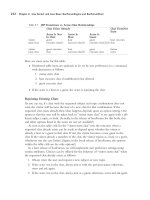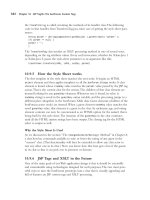The 10 Steps In Developing A Strategic Social Media Plan For Your Business
Bạn đang xem bản rút gọn của tài liệu. Xem và tải ngay bản đầy đủ của tài liệu tại đây (221.42 KB, 5 trang )
t weakyo urbiz.co m
http://tweakyo urbiz.com/management/2013/02/08/the-10-steps-in-develo ping-a-strategic-social-media-plan-fo r-yo ur-
business/
The 10 Steps In Developing A Strategic Social Media Plan For
Your Business
This post originally appeared on Niall Devitt’s blog, Niall is a regular contributor to Tweak Your Biz.
Quantifying an ROI from social media is only possible after you’ve developed a strategic plan that will make
measurement both clear and easy. When it comes to social media “80% of marketers begin with tactics
instead of goals” – eMarketer Report. Here’s how to build a strategic social media plan to ensure that
you don’t waste time or money on tactics that might work.
Why do you need to measure social media ROI?
It will never be possible to measure all aspects of social media ROI. However, this is not a good enough
reason not to measure social media ROI. Currently, only 20% of marketers actively measure ROI -
eMarketer Report
While it’s important to balance ROI with metrics that show more incremental value, if a business is to
increase profitability, customers, and to grow, then ROI remains the critical metric and the single best
measure of success over the longer term.
Start by list ening
Many companies view social media as “build it and they will come”. T hey create channels on Facebook,
Twitter and YouTube and start broadcasting their message, expecting a mass of new fans and interaction.
It doesn’t happen!
Participation on social media f irst requires you to do research, observe and listen. Conversations are
already taking place about your products, brand, competitors etc. Using a combination of both social and
traditional tools, discover, listen, learn, and engage directly with customers. Allow this intelligence and
insight to dictate your engagement strategies.
Develop a strategic social media plan
Af ter you’ve taken time to discover how customers would like you to engage on social media, you now
need to develop a social media strategy that will generate meaningf ul and real returns f or the business.
The 10 steps in developing a strategic social media are:
1. Align with the business
2. Discover opportunities
3. Def ine goals
4. Identif y KPIs
5. Assign values to KPIs
6. Decide on channels
7. Determine tactics
8. Select analytics
9. Roll out strategy
10. Measure and ref ine
# 1. Align wit h the business
A sensible social media strategy is one where the social media goals align with the business objectives.
Social media should become an extension of the business, brand and its values (the company mission
statement is of ten a great place to start).
# 2. Discover opportunities
Social media can be used f or a range of business activities including:
Marketing
Sales
Customer service
Research
Analysis
HR etc.
Within any organisation, dif f erent departments will have dif f erent goals and their associated KPIs will
vary. Speak with and analyse the requirements of each department and work out what level of resource is
available f or social media.
# 3. Define goals
Analyse any cross-over that exists and identif y any opportunities f or departments to work together f or
mutual benef it. A business shouldn’t take on social media f or all f unctions/departments, at least initially!
To help prioritize which social media goals to target:
Work out the suitability of social media to solve the particular challenge
Ref er back to the needs of the overall business
Investigate the cost of not solving the problem
Estimate and compare the potential ROIs
Speak to and get buy-in f rom senior management
Next, start to def ine a separate strategic plan f or each department.
# 4. Ident ify KPIs (key performance indicat ors)
With every goal, you will need to also identif y an associated metric/s to measure the success of social
media at solving that problem.
Choose a metric that’s indicative of that goal’s progress and is easy to measure. Social media evolves
rapidly so your tactics may have to change later. Theref ore traditional business metrics such as:
Conversions
Customers
Cost
Timings
Satisf action levels
are f ar more ef f ective at measuring social media ROI and they will be resilient to any tactical changes.
# 5. Assign values to KPIs
Work with each department to analyse and assign a monetary value to improvements across the
selected metrics.
Some metrics will be easily available, i.e. sales
For others, the specif ic department may have to do some work, i.e. customer satisf action
surveys
Seeking improvements in one area of the business will potentially impact positively on another,
i.e. an improvement in customer satisf action will have a positive ef f ect on sales.
This is more proof if needed f or departments to work more closely together using social media
tools to drive improvement across the company, i.e. sales and customer service
# 6. Decide on channels
Investigate the suitability of each social media channel to serve the specif ic goals. Don’t assume that all
social media channels are created equal, they’re not. Some will be more suitable depending on the
particular goal, i.e. Twitter is better at managing customer service goals than Facebook.
# 7. Determine tactics
Once you have decided on the most suitable social media channel/s, you will need to determine those
tactics that best serve that goal. You will be looking f or examples of tactics that are proven to work.
Start with your own sector and then branch out to include related sectors or specif ic examples that
relate to your goal/s. Search globally f or the very best case studies and understand how this inf ormation
might apply to your organisation and your selected goal/s. Tweak these tactics where necessary so that
they will work f or your organisation.
Tip: Don’t f orget that all tactics will have a cost. You will need to establish and record what these costs
are in order to accurately calculate ROI.
# 8. Select analytics
Next identif y social analytics that are relevant metrics f or each tactic.
Prioritize the ones that are most important f or the KPI f ollowed by ones that are easiest to
track.
Capture multiple analytics as some metrics may later become a better KPI af ter you have had the
experience of measuring and analysing the data.
# 9. Roll out strategy
Once you have f inalized your strategic plan, document and present it to:
Conf irm buy-in f rom individual departments and management
Add timelines and assign tasks
Identif y and provide any required training/tools/supports.
Agree and manage roll out
Only sign of f af ter the above has been agreed with management.
Tip: It is important to quickly resolve any teething issues as they appear. Ef f ective time management and
ownership of tasks will become critical in ensuring ef f ective implementation.
# 10. Measure and refine
Expect to start seeing ROI af ter about 6 months with a 12 month period giving an accurate picture. There
are two ways to measure the ROI of your social media tactics:
1. Direct results: Impacts of your social media tactics directly on your KPIs. Your website has a
conversion value of $50 and you convert 2% of traf f ic. Every 100 visits equates to $100 in sales.
You double your content output on Twitter and increase your traf f ic f rom Twitter f rom 500 to 1000
visits. The ROI is $500 less the cost of that tactic.
2. Impact of social analytics on KPIs: These are more f luid and dif f icult to measure. Taking the
above example, but this time we also implement the tactic of increasing our engagement levels with
f ollowers on Twitter by 200%. T his results in 1500 visits and an increase of 1% in the conversion
of this traf f ic. Now every 100 visits (f rom Twitter) equates to $150 in sales. The overall ROI is
$1750 less the cost of the tactics. So the ROI of engagement increase is $1250 less the cost of
that tactic.
Thanks for reading our 10 steps in developing a strategic social media plan for business. How would you
go about developing a social media strategy? What would you add?
Did you like this article? Would you like to write f or Tweak Your Biz? Or sign up f or our RSS?
Connect:
Images: ”Hand writing social media to screen/ Shutterstock.com“









